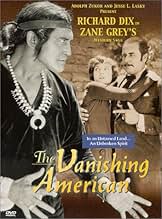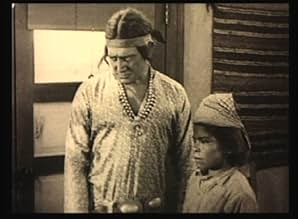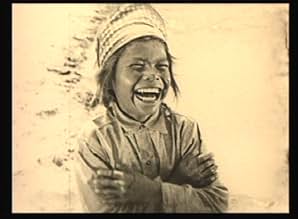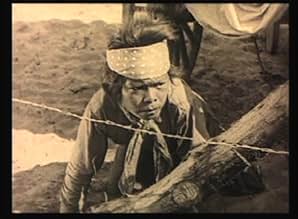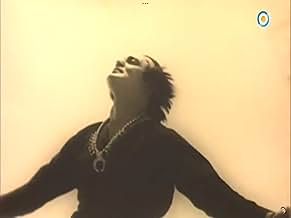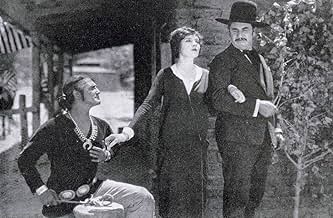Ajouter une intrigue dans votre langueA Navajo tribe suffers mistreatment by an Indian-hating agent who steals their horses. When WWI breaks out, a teacher convinces the tribe leader that enlisting will lead to better treatment.A Navajo tribe suffers mistreatment by an Indian-hating agent who steals their horses. When WWI breaks out, a teacher convinces the tribe leader that enlisting will lead to better treatment.A Navajo tribe suffers mistreatment by an Indian-hating agent who steals their horses. When WWI breaks out, a teacher convinces the tribe leader that enlisting will lead to better treatment.
- Réalisation
- Scénario
- Casting principal
- Récompenses
- 2 victoires au total
John Webb Dillion
- Naylor
- (as John Webb Dillon)
Gary Cooper
- Extra
- (non crédité)
George Magrill
- The First Nophaie
- (non crédité)
Avis à la une
Although by today's standards The Vanishing American is over the top and melodramatic it still has a fine message about the American Indian and their place in the American dream. The sad truth was that this continent did belong to them and we took it from them.
Nothing to be either proud or ashamed of. A society that ranged from hunting and gathering to the beginnings of agricultural gave way to a to an industrial and full blown agricultural society. Just the sociological way of things. Everything gives way to something in time.
That being said, the tragedy of the American Indian was not often told in these years from the Indian point of view. As a writer Zane Grey was steeped in western lore and if a white man could tell the story he could.
After a prologue showing the subjugation, we see the desert tribes of today living on government handouts, trying to maintain respectability but the victims of a corrupt Indian agent played by Noah Beery. That was the way it was back then, under Democratic or Republican administrations, the Department of the Interior was a patronage trough and characters like Noah Beery were more common than we would care to admit.
Richard Dix plays a charismatic leader of his people who actually forms an Indian battalion to fight in what was called then, The Great War. It was reasoned we fight for America as good Americans we'll be treated as such when we return. Instead its business as usual as Beery has banished the tribe to desert scrub lands. Time to return to the fighting ways of our ancestors maybe.
As Dix's character is presented and he specialized in playing noble heroes on the silent screen and when talkies arrived, the personal tragedy of this tribe is that Dix comes along about four generations too late. He's the kind of leader who might have made a difference back in the day, but can only see the futility of what his tribe is about to do.
The Vanishing American shot in what became known as John Ford's Monument Valley was a big budget item for Paramount back in the day. It's got the sweep and grandeur of a John Ford western and a little bit of the influence of Paramount's number one director Cecil B. DeMille in this one who made a spectacle film or two of note.
Though melodramatic, The Vanishing American should still be viewed for the lessons it imparts to today's audience.
Nothing to be either proud or ashamed of. A society that ranged from hunting and gathering to the beginnings of agricultural gave way to a to an industrial and full blown agricultural society. Just the sociological way of things. Everything gives way to something in time.
That being said, the tragedy of the American Indian was not often told in these years from the Indian point of view. As a writer Zane Grey was steeped in western lore and if a white man could tell the story he could.
After a prologue showing the subjugation, we see the desert tribes of today living on government handouts, trying to maintain respectability but the victims of a corrupt Indian agent played by Noah Beery. That was the way it was back then, under Democratic or Republican administrations, the Department of the Interior was a patronage trough and characters like Noah Beery were more common than we would care to admit.
Richard Dix plays a charismatic leader of his people who actually forms an Indian battalion to fight in what was called then, The Great War. It was reasoned we fight for America as good Americans we'll be treated as such when we return. Instead its business as usual as Beery has banished the tribe to desert scrub lands. Time to return to the fighting ways of our ancestors maybe.
As Dix's character is presented and he specialized in playing noble heroes on the silent screen and when talkies arrived, the personal tragedy of this tribe is that Dix comes along about four generations too late. He's the kind of leader who might have made a difference back in the day, but can only see the futility of what his tribe is about to do.
The Vanishing American shot in what became known as John Ford's Monument Valley was a big budget item for Paramount back in the day. It's got the sweep and grandeur of a John Ford western and a little bit of the influence of Paramount's number one director Cecil B. DeMille in this one who made a spectacle film or two of note.
Though melodramatic, The Vanishing American should still be viewed for the lessons it imparts to today's audience.
After a few decades interval I re-watched "The Vanishing American" (1925) with Richard Dix, Lois Wilson, Noah Beery, Sr., Malcolm McGregor, Nocki, Charles Stevens, Bernard Siegel, Shannon Day, and others. I went in this time with the attitude that I'd watch as if it were 1925, not 2020, then assess the film from both ends, realizing that the finished assessment is still my own opinion and might differ radically from anyone else, or even everyone else. Overall, the picture, directed by George B. Seitz (known perhaps best as the director of most of the "Andy Hardy" series), is not just a Western taken from a Zane Grey novel, but closer to an attempt at an "epic" saga of a series of tribal leaders who are called Nophaie of what have become known as American Indians. The film begins before neolithic times, in a time where the geography is the beginning and the people follow into the geography. We then have a neolithic presence, then a sort of tribal presence, then the American Indian, then the arrival of Spanish invaders from down in the Mezo-American regions where they've already invaded, then the somewhat contemporaneous era of American Indians on a "reservation" mandated by whites who now rule the nation. Richard Dix is the current Nophaie of all the clans and/or tribes of the Western region plotted in the film. His instant nemesis is not the current white Indian agent of the area and the reservation, but rather his assistant, Noah Beery, Sr., an evil, money-grubbing, harassing, anti-Indian sort to whom viewers take an immediate dislike because of unbecoming behaviors at several turns. The local white teacher of all the Indian children is Lois Wilson. The plot runs as a typical Western would, except Wilson and Dix fall for each other, knowing that such is not going to be accepted; and the plot favors the Indian side over the white side which is shown to be duplicitous, sometimes out-and-out evil, and under a government that seems to talk out of both sides of its mouth, though follows its own path as it sees fit. And Manifest Destiny is behind all. I'll not give the entire plot, though we do follow the Indians through WWI and their return. I found the film as a 1925 vehicle very satisfying and well done. It manifests itself as any white produced film in America in 1925 would have done, though it gave the Indian far more a share than nearly any other film of the time would have dared, and the word "dared" is the operative one.
Now, shift gears and come up to 2020. It's interesting looking at the comments of viewers who have left criticisms of the film on the IMDb. Nearly all give the film from 8 out of 10 to 10 out of 10. EXCEPT 1. The one has the moniker of 'trujillotribe'. The Trujillo homesteads of Colorado were formed in the 1860s by Hispano Americans who came there when their lands were annexed from Mexico by America. The cultural differences in everything from farming to just being who each was caused conflicts that raged for decade after decade. The one exception on the IMDb as to rating "The Vanishing American" says the plot of the film is ridiculously false, and to quote the review, "Incorrect and disrespectful, regardless of the date released." It goes on in a vein of such feelings. I wondered when I finished watching this time if my liking the film wasn't based on my learning history in the 50s and 60s when Manifest Destiny was the theme of every history book. What does that entail? In a nutshell, it accepts - and that, too, is the operative word - it accepts the fact that white Europeans came to this land in 1492 and have with their doctrine of Christianity rightfully usurped all the land and driven out heathenism and savagery.
I accept that we've come to a point in our culture where accepting Manifest Destiny in its cultural overview of our history is not only outdated, but not 'history' in the proper sense of the word. It's very one-sided. But we've come to a time where the past is being dumped as utterly BAD. "The Vanishing American" actually is a very fine film in its regard to the American Indian of 1925. The film, considering when it was made, is lucky to have found a good audience with its theme. It had to have a Richard Dix as star, or few would have gone to see it. Also in the cast in a very prominent rôle is Charles Stevens. The name isn't known much today - a shame, as he was the grandson of Geronimo - and a terrific actor in his own right, plus a good tennis buddy of Douglas Fairbanks, Sr.! He could easily have essayed the rôle Richard Dix does, but would have found his audience not as wide as movie moguls would have needed to pay the bills. Interestingly, too, he plays the part of an Indian (and, of course, IS one) who has a thing for Gekin Yashi, NOT played by a Native American female, but by Shannon Day, a New York City born white woman who played several Indian and Mexican parts in her 29 film career!
Not to utterly belabor my thoughts, I enjoyed seeing this again, and I realize that I now live in a time that accepting white people playing native American parts is basically taboo, especially when the theme of the film is one where the whites are not necessarily the good guys. I found an interesting commentary by Richard Allen and Tom Holm which has this to say about the film: "...Were George Seitz and Zane Grey attempting to demonstrate that Christianity alone cannot save Native Americans? The film has the rudiments of an overriding theme of inevitable despair. In short, the fate of the cinematic Native American soldier is heroism for naught..."
I think the film should be watched, first, as a cinematographic masterpiece (Harry Perry and Charles Edgar Schoenbaum did the cinematography, much of which is borrowed again almost EXACTLY in "The Searchers" by John Ford), second, as an attempt by early Hollywood to exact a form of retribution for Manifest Destiny, whether it is appreciated a hundred years later or not, and, third, just because it plays very well without trying to belittle a race mercilessly and tells a good, if tragic, story.
Now, shift gears and come up to 2020. It's interesting looking at the comments of viewers who have left criticisms of the film on the IMDb. Nearly all give the film from 8 out of 10 to 10 out of 10. EXCEPT 1. The one has the moniker of 'trujillotribe'. The Trujillo homesteads of Colorado were formed in the 1860s by Hispano Americans who came there when their lands were annexed from Mexico by America. The cultural differences in everything from farming to just being who each was caused conflicts that raged for decade after decade. The one exception on the IMDb as to rating "The Vanishing American" says the plot of the film is ridiculously false, and to quote the review, "Incorrect and disrespectful, regardless of the date released." It goes on in a vein of such feelings. I wondered when I finished watching this time if my liking the film wasn't based on my learning history in the 50s and 60s when Manifest Destiny was the theme of every history book. What does that entail? In a nutshell, it accepts - and that, too, is the operative word - it accepts the fact that white Europeans came to this land in 1492 and have with their doctrine of Christianity rightfully usurped all the land and driven out heathenism and savagery.
I accept that we've come to a point in our culture where accepting Manifest Destiny in its cultural overview of our history is not only outdated, but not 'history' in the proper sense of the word. It's very one-sided. But we've come to a time where the past is being dumped as utterly BAD. "The Vanishing American" actually is a very fine film in its regard to the American Indian of 1925. The film, considering when it was made, is lucky to have found a good audience with its theme. It had to have a Richard Dix as star, or few would have gone to see it. Also in the cast in a very prominent rôle is Charles Stevens. The name isn't known much today - a shame, as he was the grandson of Geronimo - and a terrific actor in his own right, plus a good tennis buddy of Douglas Fairbanks, Sr.! He could easily have essayed the rôle Richard Dix does, but would have found his audience not as wide as movie moguls would have needed to pay the bills. Interestingly, too, he plays the part of an Indian (and, of course, IS one) who has a thing for Gekin Yashi, NOT played by a Native American female, but by Shannon Day, a New York City born white woman who played several Indian and Mexican parts in her 29 film career!
Not to utterly belabor my thoughts, I enjoyed seeing this again, and I realize that I now live in a time that accepting white people playing native American parts is basically taboo, especially when the theme of the film is one where the whites are not necessarily the good guys. I found an interesting commentary by Richard Allen and Tom Holm which has this to say about the film: "...Were George Seitz and Zane Grey attempting to demonstrate that Christianity alone cannot save Native Americans? The film has the rudiments of an overriding theme of inevitable despair. In short, the fate of the cinematic Native American soldier is heroism for naught..."
I think the film should be watched, first, as a cinematographic masterpiece (Harry Perry and Charles Edgar Schoenbaum did the cinematography, much of which is borrowed again almost EXACTLY in "The Searchers" by John Ford), second, as an attempt by early Hollywood to exact a form of retribution for Manifest Destiny, whether it is appreciated a hundred years later or not, and, third, just because it plays very well without trying to belittle a race mercilessly and tells a good, if tragic, story.
A great epic. The proof that George B. Seitz was a great director. A very fine cast. Dix and Wilson are outstanding. The story takes you from the time of the dinosaurs to our days in a very convincing way.
This excellent movie far transcends its own genre, with a resourceful and detailed production that makes for a worthy treatment of some thought-provoking themes. Adapted from the Zane Grey novel, it easily does justice to the interesting story, but it is much more than just a good melodrama. Ambitous in its scale, in its time-span, and in its themes, it puts the main story into a context that is as interesting to watch as it is challenging to many of the common conceptions about the history of the American West.
The main story features Richard Dix as a Native American on a reservation, who must contend with a wide range of persons from the 'white' races. Dix succeeds in making his character interesting, believable, and sympathetic. In particular, he does well with portraying the inner torment and longings of a perceptive and capable man who is forced by his environment to keep a lot of things inside.
The 'white' characters work well, and they are well-chosen so as to avoid a simplistic portrayal of those who went west. Noah Beery plays the villainous Booker effectively, making his ill intentions clear even when his character is at his most charming, yet at the same making it believable that such a reprehensible character could so often gain the upper hand. Lois Wilson is rather meek, but she works well with Dix in the relationship that is at the center of the story.
All of that would be good enough (and it doesn't even mention the beautiful scenery and photography in Monument Valley), but what makes the movie even better is that it is set in a broader context, which places the lengthy, heart-rending clash of cultures in the American West into a sweeping, far more comprehensive picture of the unending struggle of human cultures and societies as they rise and fall through the centuries. It balances a number of perspectives, and believably shows how complex the interplay between different cultures can be.
The lengthy prologue, often detailed and interesting in itself, paints a convincing and often harrowing picture of the nature of human societies in their struggles and rivalries through the ages. It adds a depth rarely seen to the eventual conflicts between the expanding USA and the Native American nations, and even if it were made today, it would be a bold statement that challenges stereotypes of all kinds. True indeed is the movie's theme that human cultures come and go, and that those standing strong today will someday pass away, with only the earth itself remaining always.
This movie surely deserves to be much better-known, for its top quality production of some often challenging material, its interesting story, and its themes that are worthy of careful and honest consideration. If it were filmed today, some of the details would probably be handled differently, but that is to a large degree a matter of style or fashion. The specific details are far less important than the movie's impressive depth and quality.
The main story features Richard Dix as a Native American on a reservation, who must contend with a wide range of persons from the 'white' races. Dix succeeds in making his character interesting, believable, and sympathetic. In particular, he does well with portraying the inner torment and longings of a perceptive and capable man who is forced by his environment to keep a lot of things inside.
The 'white' characters work well, and they are well-chosen so as to avoid a simplistic portrayal of those who went west. Noah Beery plays the villainous Booker effectively, making his ill intentions clear even when his character is at his most charming, yet at the same making it believable that such a reprehensible character could so often gain the upper hand. Lois Wilson is rather meek, but she works well with Dix in the relationship that is at the center of the story.
All of that would be good enough (and it doesn't even mention the beautiful scenery and photography in Monument Valley), but what makes the movie even better is that it is set in a broader context, which places the lengthy, heart-rending clash of cultures in the American West into a sweeping, far more comprehensive picture of the unending struggle of human cultures and societies as they rise and fall through the centuries. It balances a number of perspectives, and believably shows how complex the interplay between different cultures can be.
The lengthy prologue, often detailed and interesting in itself, paints a convincing and often harrowing picture of the nature of human societies in their struggles and rivalries through the ages. It adds a depth rarely seen to the eventual conflicts between the expanding USA and the Native American nations, and even if it were made today, it would be a bold statement that challenges stereotypes of all kinds. True indeed is the movie's theme that human cultures come and go, and that those standing strong today will someday pass away, with only the earth itself remaining always.
This movie surely deserves to be much better-known, for its top quality production of some often challenging material, its interesting story, and its themes that are worthy of careful and honest consideration. If it were filmed today, some of the details would probably be handled differently, but that is to a large degree a matter of style or fashion. The specific details are far less important than the movie's impressive depth and quality.
Okay, it is very possible to quibble with this film if you are too wrapped up in political correctness. Sure, it's a real shame that the film starred the white actor, Richard Dix, in dark paint as the Indian lead in the film. However, having White actors play Indians was pretty much the rule up to the 1960s, so I could easily overlook this. And, the beginning of the film can seem a tad preachy and irrelevant (though I liked it, Leonard Maltin's Guide knocked this section of the film). However, given that the film was made in the rather racist 1920s (when the KKK was on the rise and one of the strongest political forces in America), it is a truly amazing and transcendent film that definitely deserves to be seen and appreciated.
Unlike the typical cowboy movie of the day, the Indians in the film are neither blood-thirsty savages nor are they simple-minded. Instead, the are uniformly shown as decent Americans who want a fair shake and a part of the American Dream. In fact, their desire to become TRUE Americans and their love of their country make this a great patriotic film. While based on all the horrible injustices they received in the film, their fundamental decency seems amazing.
In addition to excellent acting, writing and direction, special attention must be focused on the spectacular and breathtaking cinematography--especially towards the beginning of the film. The scenes of the Grand Canyon are among the most beautiful ever filmed during the silent era and are in many ways reminiscent of moving versions of Ansel Adams photos. The film is a true work of art.
Unlike the typical cowboy movie of the day, the Indians in the film are neither blood-thirsty savages nor are they simple-minded. Instead, the are uniformly shown as decent Americans who want a fair shake and a part of the American Dream. In fact, their desire to become TRUE Americans and their love of their country make this a great patriotic film. While based on all the horrible injustices they received in the film, their fundamental decency seems amazing.
In addition to excellent acting, writing and direction, special attention must be focused on the spectacular and breathtaking cinematography--especially towards the beginning of the film. The scenes of the Grand Canyon are among the most beautiful ever filmed during the silent era and are in many ways reminiscent of moving versions of Ansel Adams photos. The film is a true work of art.
Le saviez-vous
- AnecdotesThe legend that John Ford "discovered" Monument Valley (or John Wayne did and Ford took credit for it), or Harry Goulding (the trading post owner there) introduced Ford to this unique location in 1938 for La Chevauchée fantastique (1939), is disproved by the fact that this movie was filmed there in 1925.
- ConnexionsFeatured in The House That Shadows Built (1931)
Meilleurs choix
Connectez-vous pour évaluer et suivre la liste de favoris afin de recevoir des recommandations personnalisées
Détails
Box-office
- Montant brut aux États-Unis et au Canada
- 286 809 $US
- Durée
- 1h 50min(110 min)
- Mixage
- Rapport de forme
- 1.33 : 1
Contribuer à cette page
Suggérer une modification ou ajouter du contenu manquant

